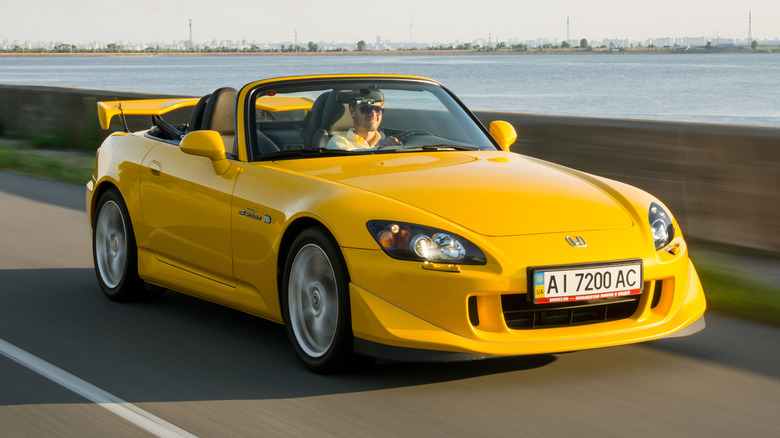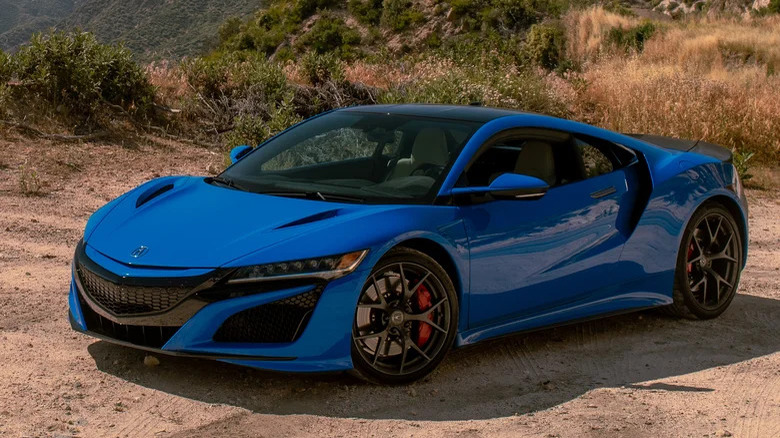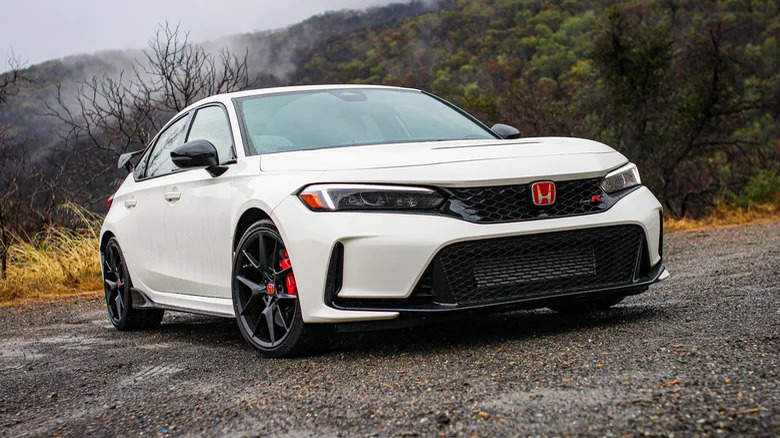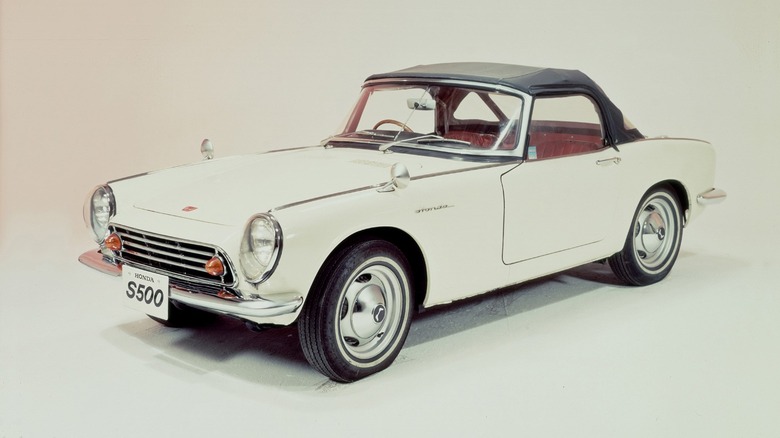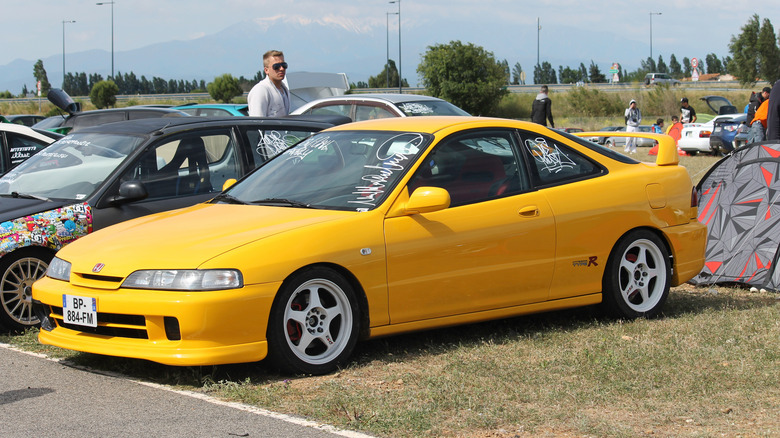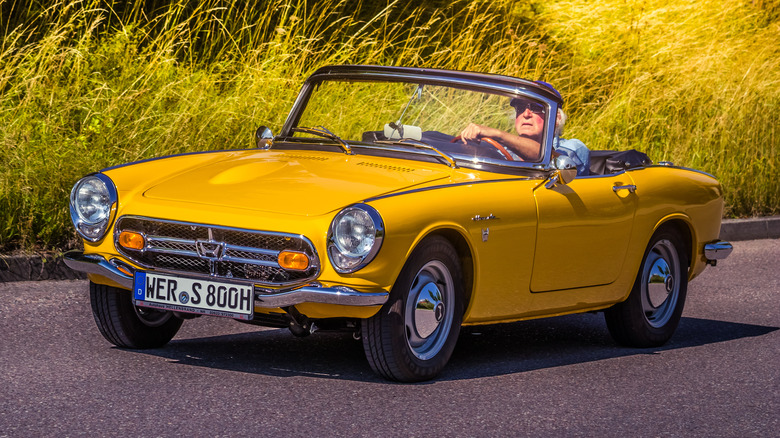10 Of The Best Honda Sports Cars Ever Made, Ranked
Ever since it first began making passenger cars in the '60s, Honda has been churning out sports cars. Its early exterior designs might have taken inspiration from European rivals, but the engineering processes behind each one were thoroughly Japanese, and that made them stand out from the rest. Over the decades, those processes have been refined and new ones developed, keeping Honda on the bleeding edge of sports car development.
Even in recent years, its work on improving the latest NSX proves that the company still cares about making the best sports car it possibly can. Narrowing the brand's back catalog down into a list of 10 best sports cars is no easy task, and it seems like potential new entrants might be just around the corner too. If the rumors are to be believed, a new electric Honda sports car is set to be unveiled very soon, but we think these 10 represent the very best of the brand's output so far.
10. Honda S660
Honda's history of making tiny sports cars goes all the way back to its earliest days, but the S660 is the most recent of the bunch. It was launched for the 2015 model year in Japan only, although there were rumors that, at one point, an export version of the car was in development. That global market version never arrived, and the JDM S660's modest performance stats made it unsuitable for sales outside of its home territory — as a kei car, it was limited to just 63 horsepower and a 660cc engine.
Acceleration was, as expected, relatively modest, although, with such little weight to haul around, the S660 could hold its own against bigger sports cars in the corners. The engine itself was mid-mounted for optimal weight distribution, and the sole transmission option was a six-speed manual. It might be very much a niche sports car designed for Japan's tight, winding roads, but it proved to be popular, with over 30,000 examples sold by the time it was retired in 2022.
Much like its predecessor, the Honda Beat, the S660 is likely to become a cult classic as the decades pass. For now, it remains an affordable, pint-sized roadster that exemplifies the back-to-basic driving experience that so many enthusiasts yearn for.
9. Honda CRX Si
It might not have been the fastest or most hair-raising car of its day, but the many unique features of the Honda CRX Si have ensured it remains a collectible classic long after its contemporaries were forgotten. The CRX was based on the underpinnings of the Civic but featured sportier styling inspired by the Zagato-designed Alfa Romeo Junior. The Si was the range-topping variant, with the U.S. market version of the car making 91 horsepower.
It also came with plenty of extras over the standard CRX, including a sunroof and rear window wipers. Small additions for sure, but ones that proved to be enticing to buyers, as the Si became a sales hit when it debuted in 1985. It remains the most collectible variant of the CRX, and like many Japanese classics, resale values are rising.
However, prices remain affordable for now, with clean examples available from around $15,000 and modified or project examples available for even less. Perhaps that's only fitting, as the Si cost just $7,999 new, making it cheaper than most of its rivals yet arguably more fun to drive than any of them.
8. Honda NSX (NC1)
The second-generation Honda NSX, sold under the Acura brand in North America, was a controversial car. It had a lot to live up to — the first-generation NSX is regarded as one of the most influential Japanese cars of its era. The new car offered a mix of tech, practicality, and performance with its hybrid drivetrain and plentiful driving assists, but it fell flat in the eyes of some enthusiasts.
However, after spending some time driving the car through the mountains of California, SlashGear concluded that the naysayers were simply wrong about the NSX. Its accessibility is what differentiates it from the rest of the supercar crowd. It's addictively easy to drive at full throttle, yet it's comfortable enough to make sitting in Los Angeles traffic a bearable experience.
Ironically, much like its predecessor, it might take years yet before the second-generation NSX's legacy is fully understood. After all, the hybrid powertrain and driving assists that caused so much debate when the car was unveiled are now standard in almost every supercar. For now, though, the NSX remains an underappreciated gem.
7. Honda Civic Type R (EK9)
The first Civic to wear the Type R badge was the EK9, and even though its performance isn't exceptional by modern standards, it's undoubtedly one of the best hot hatches of its era. Its 1.6-liter engine produces 182 horsepower, nearly double what was on offer in the base spec Civic at the time. That engine was designed especially for the Type R, with peak torque arriving at 7,500 rpm and peak horsepower at 8,200 rpm. This was a car that begged to be driven hard, and many owners did. As a result, there are relatively few survivors in pristine condition today.
The first generation of the Type R was only ever sold in Japan, although several examples have found their way to various export markets in the decades since its release. Around 16,000 units were sold over the original production run, but many have since been claimed by rust, wear and tear, accidents, or a combination of all three. It might be a rarity, but it's well worth searching out for anyone looking for the ultimate JDM hot hatch. It might look relatively unremarkable from the outside, but the original Type R is anything but.
6. Honda S2000
It wasn't just the high-revving engine that made the Honda S2000 so special, but then again, few modern mills come close to delivering such a unique driving experience. The engine wasn't universally liked at launch, mostly because it lacked power at lower revs, but the later 2.2-liter engine went some way to addressing the shortcomings of the 2.0-liter. Still, some journalists and enthusiasts weren't happy, but perhaps that was inevitable when the S2000 was so unlike anything else on the market at the time.
It needed to be pushed to the upper echelons of its rev range to be at its best, and inevitably that meant it was best suited to long, winding roads rather than highways or, even worse, urban traffic. However, find the right stretch of road, and the S2000 comes to life. Like many aging sports cars, it has its fair share of quirks that buyers should beware of, but it's proven to be one of the most reliable sports cars of its era when looked after properly.
5. Honda Civic Type R (FL5)
The latest and greatest version of the Civic Type R continues to be just as potent as its predecessors, with 315 horsepower and 310 pound-foot of torque available from its 2.0-liter turbo-four engine. The original EK9 Type R was a track day weapon, and the latest FL5 does nothing to change that, even in the wet conditions of our test drive. It's equally adept on the road, striking the balance between performance and everyday comfort.
The six-speed manual transmission was a particular highlight during SlashGear's time with the car, being both unrelentingly smooth and easy to master thanks to the rev-matching assist. At roughly $43,000, the Type R is not what most people would consider a bargain — this is still a Civic, after all — but it's well worth the price of entry for anyone looking for a track day toy that's equally comfortable doing daily driver duty.
4. Honda S500
Honda's first-ever passenger car was a sports car called the S500. Incidentally, it debuted at the 1962 Tokyo Motor Show just across the floor from Toyota's first sports car, the Sports 800. Its name came from its engine displacement, which measured 492cc in the original prototype but was later enlarged to 531cc for the production car. To drum up publicity for the car's launch, Honda created a competition for the public to guess the starting price of the new car, which garnered over 5 million entries. Predictably, the price was lower than most envisioned, at ¥459,000 (roughly $16,250 in today's money).
The success of the S500 encouraged Honda to further develop its "S" sports car line, alongside developing larger cars for both the Japanese and the American markets. Although later models in the S-line would eventually become available around the world, the S500 never ended up being sold outside of Japan, making surviving examples tricky to find today. On the rare occasion one does change hands, it can fetch north of $50,000.
3. Honda Integra Type R (DC2)
Honda's back catalog of front-wheel drive sports cars is arguably one of the greatest of any carmaker, and no car epitomizes that greatness more than the DC2 Integra Type R. It's considered by many to be among the best handling front-wheel drive cars ever produced and, yet, it sports a relatively modest power output of 187 horsepower. Its secret is its lightweight and stripped-back design, with almost nothing included in the car that doesn't need to be there. Well, that and a sprinkle of whatever chassis magic Honda's engineers managed to concoct back in the '90s.
Like many sporty Hondas, the Integra Type R proved very popular with the modding crowd, and clean, stock examples are in increasingly short supply. Those that remain pristine command a premium on the resale market, but they're still not out of reach, at least not yet. The Integra Type R is a must-drive car for any JDM fan, Honda fan, or front-wheel drive connoisseur. In fact, anyone that gets the chance to get behind the wheel of one certainly should do.
2. Honda S800
An evolution of the S500 and the S600, the S800 saw Honda's little sports car line go global. The car was sold in Western export markets as well as in Japan, with its 791cc engine remaining unchanged across all markets. That engine only produced around 70 horsepower, but considering the car weighed just 1,700 pounds, it was still sprightly to drive.
It sported a very distinctive soundtrack in part thanks to the engine's 8,500 rpm redline. Its initial design was heavily inspired by the British sports cars of the era, and at a glance, it might not look all that different, but it was under the hood where the real innovation lay.
The diminutive roadster was to be the last in the initial run of S-line sports cars, with its eventual successor, the S2000, not breaking cover until the late '90s. The S800 was discontinued after 1970, but many Hondas over the following years took influence from the car's design and high-revving nature.
1. Honda NSX (NA1/NA2)
Perhaps Honda's most influential model in terms of how it shaped the rest of the sports car industry, the original NSX was a real groundbreaker when it launched in 1990. Its design and versatility heavily inspired the design of the McLaren F1, its performance forced Ferrari to up its game with the F355, and its headline-grabbing status helped establish the Acura brand in America. With all that in mind, it's no surprise that prices for the car are on the rise as demand from collectors increases and the supply of clean examples diminishes.
The NSX's design was inspired by the F16 fighter jet and looked unlike anything else on the market at the time. Its construction was similarly cutting edge, with an aluminum monocoque chassis used to reduce weight without compromising on rigidity. Performance was also impressive for the era, even if it doesn't look so today.
Arguably the biggest achievement of the NSX was that it forced other carmakers to innovate. With such a futuristic, versatile car on sale, Honda's rivals were instantly dated in comparison. Over the following years, a period of intense development followed that saw, among many other things, the birth of the hypercar. But, things might not have panned out that way were it not for the launch of the NSX.
